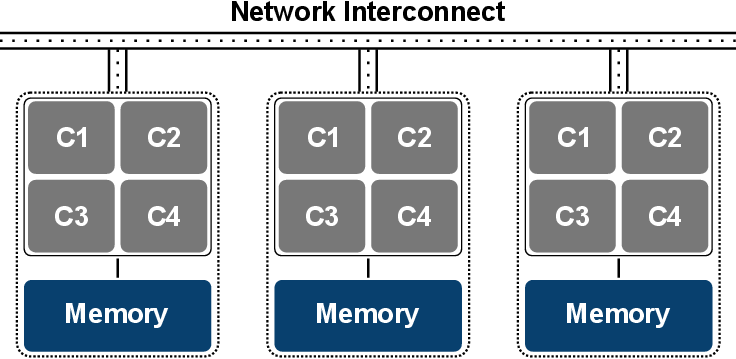
Today’s supercomputers and clusters are primarily hierarchical systems, also called hybrids. Such systems denote a mixture of systems based on different parallel memory models (Figure 5.5). The most prominent example are supercomputers with shared-memory nodes3 interconnected via a network. Therefore, hybrids are neither purely shared nor are they purely distributed, further contributing to the challenge of parallel software engineering.
In fact, hybrids may be utilized by solely applying a distributed programming model, but hybrid models are supported as well, such as MPI in tandem with OpenMP. A typical approach is to utilize MPI for inter-node communication, and a shared-memory approach, e.g., OpenMP, on the individual nodes.

If the node’s infrastructure offers a NUMA architecture, it may become a viable option to assign several MPI processes to a node and pin one, for instance, to each CPU socket4 . For example, for each socket an MPI process can be assigned rather than using one MPI process for the whole node. On the right platform, such an approach reduces NUMA effects. Another considerable aspect is the node’s memory-core ratio, where the sweet-spot5 in today’s systems is typically around 1-2 GB/core. Therefore, using one MPI process for each core might become challenging with memory intensive applications, as a node might not offer enough memory to accommodate a given problem. This becomes evident when considering a typical node setup used in current cutting-edge supercomputers, such as Titan [141], which is based on single-socket nodes offering a 16-core CPU and 32GB of shared memory. If 16 MPI processes are executed on such a node, each MPI process has access to merely 2GB of memory. A ratio of one is provided by the Sequoia supercomputer, offering 16 compute cores and 16GB of system memory on each node [142]. The observed node setups also depict an interesting fact based on the continued microprocessor scaling: a single CPU can now hold up to 16 compute cores, allowing to build cheaper single-socket nodes rather than the significantly more expensive multi-socket systems. This enables to remain cost efficient by simultaneously providing high core numbers. This trend towards higher core numbers per CPU is likely to continue [143]. At this point it becomes evident that due to the high degree of anisotropy of the available parallel target platforms, developing reasonably scaling software for such platforms is one of the major challenges today and especially in the future [144].